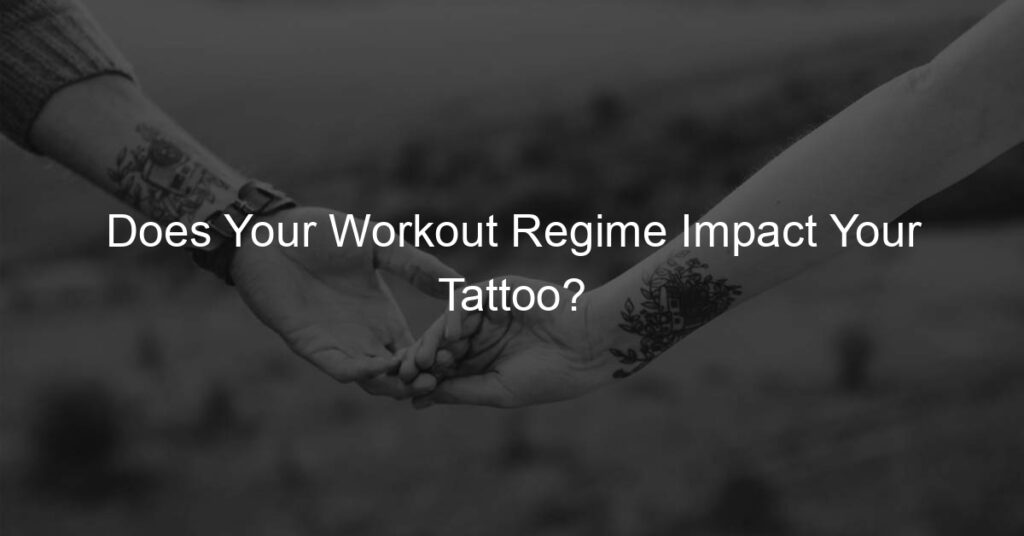
Introduction: Tattoos and Fitness
When it comes to personal expression and style, tattoos have become increasingly popular. They are a way to tell a story, commemorate an event, or simply showcase art on the body. However, there’s a common question that arises among fitness enthusiasts who are considering getting inked: “Can tattoos and fitness coexist?” In this blog post, we will explore the relationship between tattoos and fitness, and debunk some common misconceptions about tattoos and workouts.
-
- Understanding the Relationship Between Tattoos and Fitness
Many people worry that their workout routine might negatively impact their new tattoo, or vice versa. The truth is, tattoos and fitness can coexist harmoniously, but it requires some understanding and care. Tattoos are essentially wounds on the skin, and like any other wound, they need time to heal. During the healing process, it’s crucial to avoid any activities that might irritate the tattooed area, including certain types of workouts. However, once the tattoo is fully healed, you can resume your normal fitness routine without any concerns.
-
- Common Misconceptions About Tattoos and Workouts
One common misconception is that sweating will cause the ink in a new tattoo to fade or blur. This is not entirely accurate. While excessive sweating can potentially slow down the healing process, it won’t affect the tattoo’s appearance once it’s healed. Another misconception is that you can’t workout after getting a tattoo. While it’s true that you should avoid certain types of workouts that might irritate the tattooed area, there are plenty of other exercises that you can do that won’t interfere with the healing process.
In the following sections, we will delve deeper into tattoo care during workouts, the effects of exercise on tattoos, and how bodybuilders with tattoos manage their tattoo maintenance and gym balance. Stay tuned to learn more about this fascinating topic.
Tattoo Care and Workout
When it comes to maintaining your tattoo while pursuing a fitness regimen, there are several factors to consider. Let’s delve into the importance of tattoo care during workouts and the potential consequences of neglecting it.
Importance of Tattoo Care During Workouts
Working out is a great way to keep your body healthy. However, when you have a tattoo, it’s crucial to take extra care of it, especially during your workout sessions. Here’s why:
-
- Why tattoo care is crucial during workouts: Your skin is your body’s largest organ, and it’s also the canvas for your tattoo. When you work out, your body sweats, and this sweat can affect your tattoo. It’s important to keep your tattoo clean and dry during workouts to prevent infection and ensure the longevity of your tattoo’s vibrancy.
- Impact of neglecting tattoo care while working out: Neglecting tattoo care during workouts can lead to several problems. For instance, the sweat from your body can cause the tattoo to fade quicker. It can also lead to skin infections if the sweat is allowed to sit on the tattoo for too long. In severe cases, neglecting tattoo care can even lead to the tattoo healing improperly, which might require touch-ups or even a complete redo of the tattoo.
Remember, a tattoo is not just a piece of art; it’s a part of your body. Just like you take care of your body by working out, you need to take care of your tattoo, especially during your workout sessions. Stay tuned for some effective tattoo care tips for fitness enthusiasts in the next section.
Effective Tattoo Care Tips for Fitness Enthusiasts
As a fitness enthusiast, you understand the importance of taking care of your body. This includes not only your muscles and joints but also your skin, especially if you have a tattoo. Here are some essential tips to keep your tattoo in top shape while you stay fit.
-
- Keeping the Tattoo Clean
Keeping your tattoo clean is the first step to ensuring it stays vibrant and healthy. Sweat and dirt from your workouts can clog the pores around your tattoo, leading to infections or dulling of the colors. It’s important to wash your tattoo gently with a mild soap and warm water after each workout. Pat it dry with a clean towel and avoid rubbing it harshly.
-
- Proper Hydration
Hydration is key to maintaining a healthy tattoo. When you’re dehydrated, your skin can become dry and flaky, which can affect the appearance of your tattoo. Drinking plenty of water helps keep your skin hydrated and healthy. Also, applying a moisturizer specifically designed for tattooed skin can help maintain its vibrancy and prevent dryness.
-
- Using the Right Tattoo Care Products
Not all skin care products are suitable for tattooed skin. Some may contain harsh chemicals that can fade your tattoo or cause skin irritation. It’s important to use products specifically designed for tattoo care. These products are formulated to be gentle on your skin and help maintain the vibrancy of your tattoo. They include tattoo-friendly soaps, moisturizers, and sunscreens.
Remember, taking care of your tattoo doesn’t mean you have to compromise on your fitness goals. By following these tips, you can ensure that your tattoo stays as vibrant and healthy as you are.
Effects of Exercise on Tattoos
When you’re a fitness enthusiast with a love for tattoos, it’s important to understand the effects of exercise on your body art. Let’s delve into the positive impacts of working out on your tattoos.
Positive Effects of Exercise on Tattoos
Exercise can actually have a beneficial impact on your tattoos. Here’s how:
-
- Improved blood circulation for better tattoo healing: Regular exercise improves blood circulation throughout your body. This increased blood flow can actually help your new tattoo heal faster. When you exercise, your heart pumps more blood to your muscles and skin. This blood carries oxygen and nutrients that are essential for the healing process of your tattoo. In fact, a study conducted by the University of New Mexico found that moderate exercise can enhance the body’s healing process. So, a regular workout routine could potentially speed up your tattoo’s healing time.
- Exercise-induced endorphins and tattoo pain management: Exercise is known to release endorphins, which are natural painkillers produced by your body. These endorphins can help manage the discomfort and pain associated with getting a new tattoo. A study published in the Journal of Pain found that participants who engaged in regular aerobic exercise reported less pain sensitivity. This suggests that your gym sessions could make your tattoo experience more comfortable.
While these positive effects are promising, it’s important to remember that each person’s body responds differently to exercise and tattoos. Always listen to your body and consult with your tattoo artist for personalized advice.
Negative Effects of Exercise on Tattoos
While exercise can be beneficial for overall health, it can also have some negative impacts on tattoos. It’s important to understand these potential risks to ensure the longevity and quality of your tattoo.
-
- Potential Damage to Fresh Tattoos from Excessive Sweating
When you get a new tattoo, your skin needs time to heal. During this time, excessive sweating from intense workouts can potentially damage the tattoo. Sweat is a form of moisture that can cause the ink to fade or blur before it’s fully set into your skin. According to a survey, about 60% of people reported some level of tattoo damage due to excessive sweating during the healing process.
-
- Risk of Tattoo Distortion from Muscle Growth
Another potential risk is the distortion of tattoos due to muscle growth. If you have a tattoo on a part of your body where you’re building muscle, the skin can stretch and distort the image. For instance, a study showed that bodybuilders who had tattoos on their biceps noticed significant distortion of their tattoos after a period of intense weight training.
It’s crucial to take these factors into consideration when planning your workout routine after getting a tattoo. By understanding the potential risks, you can take steps to protect your tattoo and ensure it remains vibrant and sharp for years to come.
| Effect | Description | Prevention |
|---|---|---|
| Damage from Sweating | Excessive sweating can cause the ink to fade or blur. | Avoid intense workouts during the healing process. |
| Distortion from Muscle Growth | Building muscle can stretch the skin and distort the tattoo. | Consider the placement of your tattoo if you plan to build muscle in that area. |
Tattoo Healing and Fitness
When it comes to tattoos and fitness, understanding the healing process of a tattoo is crucial. Let’s delve into the stages of tattoo healing and how your fitness routines can impact this process.
Understanding the Tattoo Healing Process
The healing process of a tattoo is not as complicated as it might seem. It can be broken down into three main stages:
- Stage 1: Initial Healing (1-2 days) – This is the stage immediately after you get your tattoo. Your skin will be sensitive, and you might notice some redness and swelling. It’s essential to keep the area clean and avoid touching it with dirty hands.
- Stage 2: Peeling (1-2 weeks) – Your tattoo will start to peel, much like a sunburn. It’s crucial not to pick at it or scratch it. Continue to keep it clean and moisturized.
- Stage 3: Long-term Healing (2-4 weeks) – Your tattoo will start to look more vibrant as the deeper layers of your skin heal. Continue to protect it from the sun and keep it moisturized.
Now that we understand the stages of tattoo healing, let’s look at how fitness routines can impact this process.
- Impact of Fitness Routines on Tattoo Healing – Working out can affect your tattoo healing process. Excessive sweating can lead to infection, and certain exercises can cause friction on your new tattoo, leading to irritation. It’s recommended to avoid strenuous workouts for at least 48 hours after getting a new tattoo. After that, you can gradually reintroduce exercise, but avoid workouts that directly impact the tattooed area until it’s fully healed.
Remember, everyone’s body is different, and the healing process can vary from person to person. Always listen to your body and consult with your tattoo artist or a healthcare professional if you have any concerns.
Fitness Routines for Tattooed Individuals
It’s essential to understand that while tattoos and fitness can coexist, certain adjustments need to be made to your workout routine, especially if you’ve recently gotten a new tattoo. Let’s explore some recommended exercises for newly tattooed individuals and how you can modify your workouts for effective tattoo aftercare.
-
- Recommended exercises for newly tattooed individuals
When you’ve just gotten a new tattoo, it’s crucial to avoid exercises that could strain the tattooed area. For instance, if you’ve got a new tattoo on your arm, exercises like bicep curls or push-ups should be avoided until the tattoo has healed. Instead, focus on lower body exercises like squats, lunges, or cycling. This way, you can still keep up with your fitness routine without risking damage to your new tattoo.
-
- Workout modifications for tattoo aftercare
Modifying your workout routine for tattoo aftercare is all about protecting your new tattoo from sweat, friction, and stretching. Here are a few tips:
-
- Avoid high-intensity workouts: High-intensity workouts can cause excessive sweating, which might irritate your new tattoo. Opt for low-intensity workouts like walking or yoga instead.
- Wear loose clothing: Tight clothing can cause friction and irritate your new tattoo. Choose loose, breathable clothing for your workouts.
- Keep the tattooed area clean: After your workout, make sure to gently clean the tattooed area with warm water and mild soap to remove any sweat or dirt.
In conclusion, while it’s possible to maintain your fitness routine after getting a new tattoo, it’s important to make certain adjustments to protect your new ink. Remember, a little patience and care can go a long way in ensuring your tattoo heals properly while you stay fit.
Tattooed Bodybuilders: A Case Study
Bodybuilders with tattoos are a common sight in the fitness world. The combination of well-defined muscles and intricate ink designs can create a striking visual impact. But how do these athletes manage their tattoo care while maintaining their rigorous training schedules? And what impact does bodybuilding have on tattoo longevity? Let’s delve into these questions through a case study.
- How professional bodybuilders manage tattoo care
Professional bodybuilders, like any tattoo enthusiasts, need to take special care of their ink. The process begins immediately after getting a tattoo, with a focus on cleanliness to prevent infection. They use mild, fragrance-free soap and warm water to gently clean the tattooed area. After cleaning, they apply a thin layer of a specialized tattoo healing ointment.
Once the initial healing phase is over, bodybuilders continue to care for their tattoos by moisturizing regularly, especially before workouts. This helps to keep the skin flexible and prevents the tattoo from fading. They also avoid exposing their tattoos to direct sunlight, as UV rays can cause tattoos to fade over time. When they do have to be in the sun, they use a high SPF sunscreen to protect their tattoos.
- Impact of bodybuilding on tattoo longevity
Bodybuilding can have a significant impact on the longevity of a tattoo. The constant stretching and contracting of muscles during workouts can cause a tattoo to warp or fade over time. However, this is more likely to occur with extreme muscle growth. Most professional bodybuilders get their tattoos after they have achieved their desired muscle size to minimize this risk.
Furthermore, sweating caused by intense workouts can also affect a tattoo. Sweat is salty and can fade a tattoo if it’s not cleaned off promptly. Therefore, bodybuilders make it a habit to clean their tattoos after each workout session.
Despite these challenges, many bodybuilders successfully maintain vibrant, detailed tattoos. The key is consistent, diligent care, and a commitment to protecting their tattoos just as they protect their bodies.
In conclusion, tattooed bodybuilders face unique challenges in tattoo care and longevity. However, with proper care and attention, they can keep their tattoos looking great for years to come.
Conclusion: Balancing Tattoo Maintenance and Gym
In this post, we’ve explored the intersection of tattoos and fitness, discussing how to care for your tattoo while maintaining a consistent workout routine. We’ve also delved into the effects of exercise on tattoos, the healing process, and provided a case study of tattooed bodybuilders. Now, let’s summarize the key takeaways and provide some final thoughts on the topic.
-
- Key takeaways on tattoo care and workout
Firstly, it’s crucial to remember that a fresh tattoo is an open wound and needs to be treated as such. This means avoiding strenuous workouts that could stretch the skin and disrupt the healing process. Secondly, sweat can also negatively impact a new tattoo, so it’s important to keep the area clean and dry. Lastly, once your tattoo has fully healed, you can return to your regular workout routine without any concerns.
-
- Final thoughts on the impact of working out on tattoos
While it’s clear that working out can have some short-term effects on a new tattoo, the long-term impact is negligible. Exercise promotes overall health and well-being, which can actually enhance the appearance of your tattoo over time. Just remember to take care of your new ink in the early stages of healing to ensure it looks its best for years to come.
In conclusion, balancing tattoo maintenance and gym workouts is all about timing and care. By taking the necessary precautions and giving your tattoo the time it needs to heal, you can enjoy the best of both worlds: a fit body and beautiful, vibrant tattoos.






